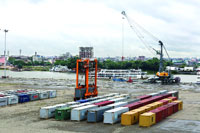
Desperate bid to make Pangaon operational
Syful Islam | Friday, 28 August 2015

The government has decided to cut user fees by 70 per cent to attract traders to the Pangaon Inland Container Terminal (ICT) in handling their export-import goods, officials said.
The decision was taken after the ICT, set up in Keraniganj of Dhaka, has remained almost unused for about two years since its inauguration in November 2013.
In 20 months of operation, the terminal handled only 1,614 TEUs (twenty-foot equivalent units) of containers, which is much lower than its at-a-time capacity of 2,400 TEUs.
The government has also decided to reduce the charge for using mobile harbour crane by 50 per cent as an incentive to attract users to the terminal.
Besides, the shipping agents will get seven days free time to keep their empty containers at the terminal. Presently, they need to pay for empty containers from the very first day.
Necessary facilities will be provided so that empty containers of Pangaon ICT and Kamalapur Inland Container Depot can be used at both establishments to reduce their idling time.
The decisions were taken based on a report of a committee of the Ministry of Shipping (MoS), headed by additional secretary Nasir Arif Mahmud, which was tasked with setting vessel rent to and from Pangaon ICT to Chittagong port for next six months.
The ICT built at a cost of Tk 1.50 billion is now carrying containers by three vessels bought by the Chittagong Port Authority (CPA) to and from the country's prime seaport.
Stakeholders said lack of adequate number of vessels to carry their export-import goods timely keep them away from the terminal.
However, officials said six to eight more vessels are likely to join the Pangaon-Chittagong route by December next. Of them, two were built by the Bangladesh Navy and six by private sectors.
At the Pangaon ICT, they said, some facilities were extended for imported cargoes, but exporters were not given the same. Exporters, their shipping agents and consolidators will be given office space to facilitate them.
"The reduction in user fee and addition of some new vessels may encourage traders to use the terminal in handling their export-import consignments," said a senior official of the MoS.
He said exporters want their cargoes to reach Chittagong port timely and shipped to mother vessels in due time which needs to be ensured by the ICT authority.
"With new vessels joining the Pangaon-ICT route, we are hopeful of carrying export-import containers in time. Now the traders will increasingly use the terminal to handle their export- import goods," he added.
Exporters Association of Bangladesh (EAB) President Abdus Salam Murshedy told the FE Thursday that traders would not be eager to use the terminal unless it is found comparatively less time- consuming and cheaper.
"We are still not clear whether using the port will be cheaper and less time-consuming. Besides, the terminal authority could not ensure that vessels will be able to reach the Chittagong port in time in line with the timetable of mother vessels."
"The rent of carrying a container of goods by water vessels has to be cheaper compared to the fare charged for carrying goods by road," Mr Murshedy said, adding that time is also a cost for exporters.
Safety and navigability of inland river route need to be maintained so that vessels are not stuck up while carrying export containers, he noted.
"An adequate number of vessels need to ply the route. When we're ready, we don't get vessels," Captain AS Chowdhury, country head of Seacon, a Singapore-based feeder-vessel operator, told the FE earlier.
He said the terminal should have become busy much earlier since Dhaka and its peripheral districts import around 60 per cent of country's total imports.
Vice President of Bangladesh Garment Manufacturers and Exporters Association (BGMEA) Shahidullah Azim told the FE earlier that still there are some procedural complications which discourage exporters to use the terminal.
"If you want to use the ICT, you will have to carry goods from factory to Pangaon. Then stockpile those in go-downs. Then again load the vessels and unload those in Chittagong port. Then load those in feeder vessels towards mother vessel. The process will cause much delay," he said.
Sending goods by road is faster than river route, Mr Azim said, adding that that's why exporters prefer to use road than river route.
syful-islam@outlook.com